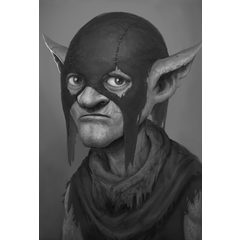8.Operating tools and palettes
Compatible with Clip Studio Paint Ver. 3.1.0
Adjusting and operating the [Layer] palette
<Adjustment of the pallet width>
When using Clip Studio Paint for the first time, try widening the width of the [Layer] palette. If the width of the pallet is too narrow, icons for necessary functions may be hidden.
You can adjust the width of the palette by dragging the edge of the palette.
<The Command bar position of the [Layer] palette>
Initially, the command bar of the [Layer] palette is located at the top. However, this can be changed to the bottom by selecting [Set command bar below list] from the menu on the upper left of the palette.
<Moving layers>
To change the order of the layers, move the cursor to the three lines (grip) displayed on the right side of the layer and drag & drop it.
You can move [Rulers] or [Layer masks] applied to a layer by selecting, dragging horizontally, and moving it to a different layer.
Setting up the [Quick Access] palette
The [Quick Access] palette is a palette that allows to register frequently used tools, commands, auto actions, and other functions. Initially, frequently used functions such as [Flip Horizontal] and [Reset Display] are already registered, but you can also easily register your own favorite functions.
① Tap the [Quick Access] palette icon to display the palette.
② Select the [Quick Access Setting] at the bottom of the palette to open the [Quick Access Setting] dialog box.
(3) Once the [Quick Access Settings] dialog is displayed, you can tap [Main Menu] at the top to open the category drop-down menu.
④ When selecting a category, the list at the bottom will change to match the category.
Select the functions you would like to register from the list and tap the [Add] button to register.
In addition to registering via the [Quick Access Settings], you can also register your favorite tool settings with drag & drop directly from a [Sub Tool Palette] to the [Quick Access] palette.
Setting up the [Command Bar]
As with the [Quick Access] palette, you can register frequently used tools, commands, auto actions, and so on in the [Command Bar]. Registering frequently used functions to the [Command Bar] can be very useful.
While things like [Create new] and [Save] are registered initially, you can register other tool settings such as brushes and colors as you prefer.
From the [Clip Studio Paint] menu, tap the [Command Bar Settings]. Then you can select the desired functions from the [Command Bar Settings] dialog box that appears and [Add] or [Delete] accordingly.
Note: Adding items works the same as with the [Quick Access] palette.
Using the Edge Keyboard
By using the edge keyboard, you can use modifier keys such as [Space], [Shift], and so on.
In addition, shortcuts can be assigned to keys [T1] to [T16].
The number of keys displayed depends on the orientation and resolution of the tablet's display.
Note: Shortcuts can be edited via the [Clip Studio Paint] menu > [Shortcut setting].
■ Galaxy/Android/Chromebook version
Tap the half-circle button at the edge of the display to show the edge keyboard. Tap the same button again to hide it.
■ iPad version
Swipe either from the left or right edge of the screen towards the canvas to display the [Edge Keyboard]. You can hide it by tapping on the keyboard and swiping it out of the screen.
If a semi-transparent edge keyboard appears when switching the display of the edge keyboard, please swipe in the same direction again.
Galaxy/Android/Chromebook: Turning Modifier Keys On/Off
In the Galaxy/Android/Chromebook version, you can switch modifier keys on and off in the following two ways.
[Push]: Modifier keys are on only while the button is pressed. This is suitable for when drawing with your fingers.
[Toggle]: Switch the modifier key on or off by tapping the button.This is suitable for when drawing with a pen.
▲ [Clip Studio Paint] menu > [Preferences] > [Interface] > [Edge Keyboard]
























Comment